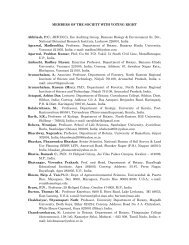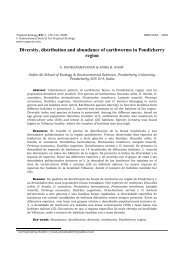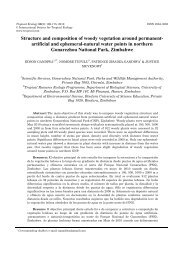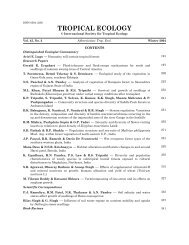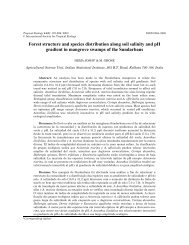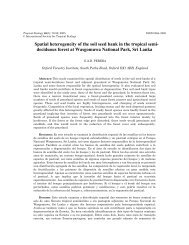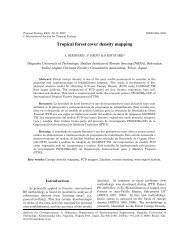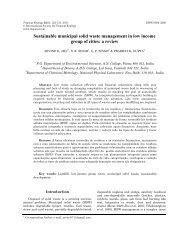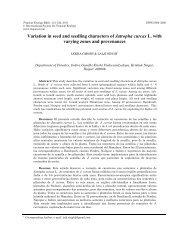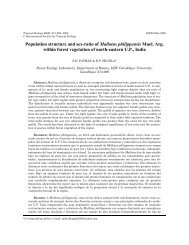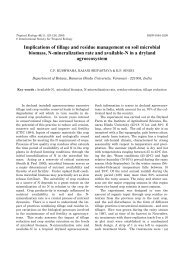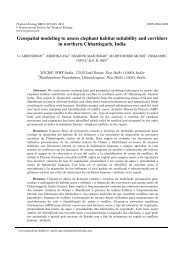Species composition and community structure of forest stands in ...
Species composition and community structure of forest stands in ...
Species composition and community structure of forest stands in ...
You also want an ePaper? Increase the reach of your titles
YUMPU automatically turns print PDFs into web optimized ePapers that Google loves.
168 FOREST STRUCTURE IN KUMAON HIMALAYA<br />
comunidades arbóreas e 17 comunidades de vegetação rasteira. A distribuição das espécies<br />
arbóreas no eixo DCA <strong>in</strong>dicam a covertura pelo copado e a diversidade dos arbustos. A primeira<br />
componente do ACP representou florestas com copado aberto a fechado, enquanto a segunda<br />
reflectiu o aumento na densidade e diversidade dos arbustos. O grupo Quercus floribunda-<br />
Rhododendron arboreum apresentou a densidade arbórea máxima e o Abies p<strong>in</strong>drow-Betula<br />
utilis o mínimo. A Myrs<strong>in</strong>e africana foi a espécie arbustiva dom<strong>in</strong>ante. A diversidade arbórea<br />
máxima e riqueza foi registada para a estação Daphiadhura enquanto a estação V<strong>in</strong>aiyak<br />
expressou a diversidade arbustiva máxima. Encontrou-se que a P<strong>in</strong>us wallichiana, Betula<br />
utilis, Tsuga demosa, etc. eram espécies arbóreas raras.<br />
Key words: Forest conservation, Himalaya, Himalayan <strong>forest</strong>s, India, ord<strong>in</strong>ation,<br />
rare species, vegetation <strong>community</strong>.<br />
Introduction<br />
Himalaya, the youngest mounta<strong>in</strong> system <strong>of</strong><br />
the world, constitutes an important l<strong>in</strong>k between<br />
the vegetation <strong>of</strong> the southern pen<strong>in</strong>sular India<br />
on the one h<strong>and</strong>, the eastern Malaysian, the<br />
north-eastern S<strong>in</strong>o-Japanese <strong>and</strong> the northern<br />
Tibetan areas on the other (Puri et al. 1983).<br />
Several studies have described the vegetation <strong>of</strong><br />
Kumaon (Dhar et al. 1997; Rikhari et al. 1989a;<br />
S<strong>in</strong>gh et al. 1984; S<strong>in</strong>gh & S<strong>in</strong>gh 1984; S<strong>in</strong>gh &<br />
S<strong>in</strong>gh 1987; S<strong>in</strong>gh et al. 1987; Tiwari & S<strong>in</strong>gh<br />
1985; Upreti et al. 1985) <strong>and</strong> Garhwal Himalaya<br />
(Anthwal et al. 2006; Kumar & Bhatt 2006;<br />
Nautiyal et al. 2004). Some <strong>of</strong> the studies<br />
described altitud<strong>in</strong>al variation <strong>in</strong> vegetation<br />
(Adhikari et al. 1992; Saxena et al. 1985) <strong>and</strong><br />
reported that vegetation types differ with change<br />
<strong>in</strong> altitude. However, Puri et al. (1983) observed<br />
that geology <strong>and</strong> soils may exercise a far greater<br />
<strong>in</strong>fluence on the distribution <strong>of</strong> vegetation types<br />
than the altitude or climate.<br />
Some pioneer<strong>in</strong>g contributions on<br />
phytosociology (Ralhan et al. 1982; Saxena &<br />
S<strong>in</strong>gh 1982) <strong>and</strong> population <strong>structure</strong> (Saxena et<br />
al. 1985; S<strong>in</strong>gh et al. 1987) <strong>of</strong> certa<strong>in</strong> central<br />
Himalayan <strong>forest</strong> types have already been<br />
reported. The ma<strong>in</strong> objectives <strong>of</strong> this paper are: (i)<br />
to describe structural attributes (density, species<br />
diversity <strong>and</strong> richness) <strong>of</strong> tree, shrub <strong>and</strong> ground<br />
layers; (ii) to identify predom<strong>in</strong>at<strong>in</strong>g communities<br />
<strong>of</strong> trees <strong>and</strong> ground vegetation, <strong>and</strong> plant species<br />
<strong>of</strong> special concern, <strong>and</strong> to further identify the<br />
localities hav<strong>in</strong>g rare plant communities need<strong>in</strong>g<br />
protection.<br />
Materials <strong>and</strong> methods<br />
Study area<br />
The study was conducted <strong>in</strong> 23 <strong>forest</strong> st<strong>and</strong>s<br />
<strong>in</strong>clud<strong>in</strong>g B<strong>in</strong>sar Wildlife Sanctuary (BWS) <strong>and</strong><br />
Askot Wildlife Sanctuary (AWS), <strong>in</strong> five districts;<br />
Almora, Bageshwer, Champawat, Na<strong>in</strong>i Tal <strong>and</strong><br />
Pithoragarh <strong>of</strong> Kumaon Himalaya (28° 43' 55" to<br />
30° 30' 12" N latitude <strong>and</strong> 78° 44' 30" to 80° 45' E<br />
longitude) cover<strong>in</strong>g an area <strong>of</strong> 21,032 km² <strong>in</strong> the<br />
Uttarakh<strong>and</strong> state <strong>of</strong> India (Fig. 1, Table 1).<br />
Kumaon Himalaya is altitud<strong>in</strong>ally divisible <strong>in</strong>to<br />
subtropical (300 to 1500 m), temperate (1500 to<br />
3500 m) <strong>and</strong> alp<strong>in</strong>e (>3500 m) zones (Saxena et al.<br />
1985). Annual ra<strong>in</strong>fall peaks at about 1200 m<br />
altitude (4100 mm) <strong>and</strong> gradually decl<strong>in</strong>es to 670<br />
mm at 2700 m (Saxena et al. 1985).<br />
Sampl<strong>in</strong>g procedures<br />
Overall 902 sampl<strong>in</strong>g plots were laid <strong>in</strong> the 23<br />
<strong>forest</strong> st<strong>and</strong>s (details <strong>in</strong> Table 1). Vegetation was<br />
sampled along exist<strong>in</strong>g <strong>forest</strong> trails which passed<br />
through all the major habitat types to permit<br />
sampl<strong>in</strong>g <strong>of</strong> different habitats <strong>in</strong> equal proportion<br />
at each site. In each st<strong>and</strong>, sampl<strong>in</strong>g plots were 50<br />
m apart, <strong>and</strong> each was laid at a distance <strong>of</strong> 10 m<br />
from the edge <strong>of</strong> the trail on either side to avoid<br />
sampl<strong>in</strong>g <strong>of</strong> the relatively disturbed vegetation.<br />
Number <strong>of</strong> plots sampled <strong>in</strong> different st<strong>and</strong>s is<br />
given <strong>in</strong> Table 1.<br />
At each sampl<strong>in</strong>g plot, a 10 m radius circular<br />
plot (Dombois & Ellenberg 1974) was established.<br />
Trees > 4 m height were considered mature trees.<br />
<strong>Species</strong> <strong>and</strong> their <strong>in</strong>dividuals were recorded for the





